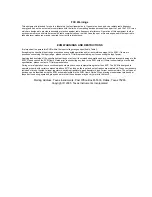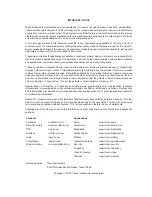
www.ti.com
1.6
EVM Operation
Introduction
Table 5. Data Input Mode Jumper Configurations
Data Input Mode
Data Input Pins
Data Output Pins
0-
Ω
Resistors
Open Resistors
Serial data input mode (default)
SIN_RED
SOUT_B
R3, R7
R2, R4, R6, R8
Parallel data input mode
SIN_RED,
SOUT_R,
R2, R4, R6, R8
R3, R7
SIN_GREEN,
SOUT_G,
SIN_BLUE
SOUT_B
1.5.1
Serial Data Input Mode
The default configuration is a serial data input connection. In this mode, each of the three TLC5940 data
streams is connected serially. Data from the TUSB3210 enters the TLC5940 board on the SIN_RED pin.
This data goes through the on-board buffer and into the SIN pin on the red TLC5940. The data passes
through this IC and through the green TLC5940 before going into the blue TLC5940. Once the data
stream has filled up the internal registers in all three TLC5940 ICs, it is latched into all ICs at the same
time.
1.5.2
Parallel Data Input Mode
When reconfigured for parallel data input, each of the three TLC5940 ICs is driven from a different data
line. Data goes into the EVM on the SIN_RED, SIN_GREEN, and SIN_BLUE inputs at the same time. The
data then goes through the on-board buffer and into the SIN pins of each TLC5940. The software only
operates in serial mode. The user must provide a driver and software to operate in parallel mode.
1.6.1
Turning on the EVM
After the software is installed and the hardware is connected as described earlier in this document, the
EVM is ready for use. The startup procedure for the EVM is as follows:
1. Connect all hardware.
2. Turn on the 3.3V and 5.5V power supplies
3. Run the LED Frame Designer software
If the USB cable is removed and reinserted while the software is running, or if power is removed from
VCC, the DOT correction data can become corrupted. To correct this problem, either push the RESET
button on the TUSB3210 PWB or click on the PLAY button in the software.
The default state at startup is to program the LED drivers to 100% DOT correction and 100% grayscale
mode. This produces a white light from the LEDs.
1.6.2
Signal Conditioning Buffer
The TLC5940EVM PWB contains a buffer to condition the input signals to the EVM. This buffer,
SN74AVC16244, eliminates any noise on the input signals, generates fast, clean rise and fall times, and
improves the drive capability of the signal. This circuitry is not necessary for operation of the TLC5940 IC.
It was added to the EVM to eliminate problems that could be caused by noisy drive signals in a test setup.
1.6.3
EEPROM Programming Voltage Supply Circuit
The TLC5940 requires 22V on the VPRG pin in order to program the internal EEPROM. This EEPROM
programming voltage supply circuit uses a TPS61040 IC to provide 22V for this purpose. The circuit
remains off until the /22V_EN signal is pulled low.
TLC5940 EVM
6
SLVU139 – September 2005
Summary of Contents for TLC5940 EVM
Page 9: ...www ti com Board Layout Figure 3 Top Layer Routing SLVU139 September 2005 TLC5940 EVM 9 ...
Page 10: ...www ti com Board Layout Figure 4 Layer 2 Routing TLC5940 EVM 10 SLVU139 September 2005 ...
Page 11: ...www ti com Board Layout Figure 5 Layer 3 Routing SLVU139 September 2005 TLC5940 EVM 11 ...
Page 12: ...www ti com Board Layout Figure 6 Bottom Layer Routing TLC5940 EVM 12 SLVU139 September 2005 ...


































